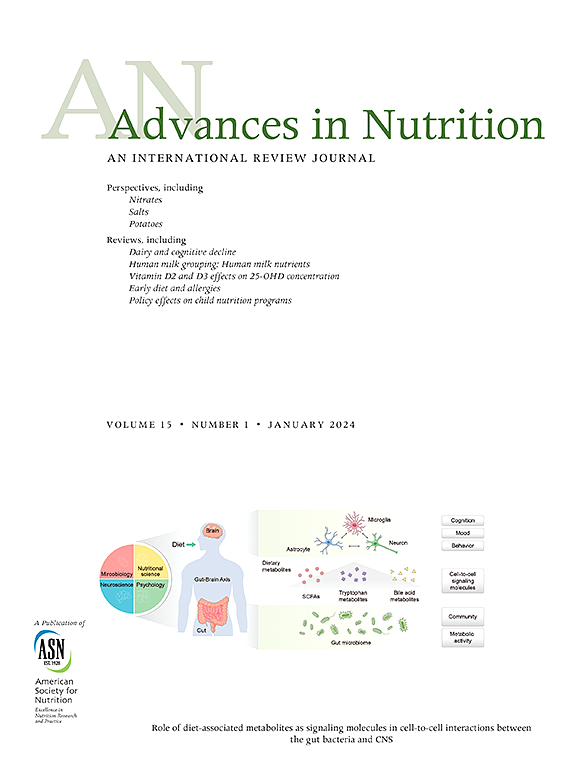数学优化在撒哈拉以南非洲以食物为基础的饮食建议发展中作为饮食建模工具的相关性:范围审查。
IF 9.2
1区 医学
Q1 NUTRITION & DIETETICS
引用次数: 0
摘要
本研究旨在了解数学规划在撒哈拉以南非洲(SSA)基于食物的饮食建议(FBRs)发展中的作用,确定当前的局限性,并强调推进循证饮食干预的机会。根据PRISMA扩展范围审查(PRISMA- scr),从2000年1月到2024年5月的系统检索确定了97项相关研究。其中,来自12个SSA国家(在SSA的48个国家和地区中)的30项研究符合纳入标准。所回顾的研究利用线性规划(LP)或线性目标规划的扩展(即线性目标规划),通过优化当前的饮食模式以满足营养需求和差距(n=24),开发营养和区域优化和成本最小化的食物篮子(n=4),以及将LP作为设计特定人群的基于食物的饮食指南的方法(n=2)来制定fbr。所审查的研究的主要目标是开发营养充足且经济上负担得起的食物模式,而不是同时解决多种慢性营养相关疾病,这反映了与资源丰富环境相比,低资源环境中饮食建模的独特优先事项。制定的fbr和优化的饮食通常是针对特定的人口群体确定的,地理范围有限,反映了区域优先事项。通过优先考虑当地可获得的食物种类和项目,可以在营养和经济上优化饮食;然而,在某些情况下,可能需要额外补充或包含很少食用的营养密集食物。数学优化,特别是LP,是解决饮食挑战和开发基于证据的、具体情况的fbr的宝贵工具。用户友好软件的可用性促进了它的使用。然而,它的成功应用需要高质量的输入数据,考虑行为和实践方面,以及跨学科的合作。高质量的输入数据和融入社会文化背景对于利用数学优化为SSA提供包容和有效的饮食建议至关重要。本文章由计算机程序翻译,如有差异,请以英文原文为准。
Relevance of Mathematical Optimization as a Tool for Diet Modeling in the Development of Food-Based Dietary Recommendations in Sub-Saharan Africa: A Scoping Review
This study aimed to understand the role of mathematical programming in the development of food-based dietary recommendations (FBRs) in sub-Saharan Africa (SSA), identify current limitations, and highlight opportunities for advancing evidence-based dietary interventions. Following the Preferred Reporting Items for Systematic Reviews and Meta-Analyses Extension for Scoping Reviews, a systematic search from January 2000 to May 2024 identified 97 relevant studies. Among these, 30 studies spanning 12 SSA countries (of 48 countries and territories in SSA) met the inclusion criteria. The reviewed studies leveraged linear programming (LP) or extensions of LP (i.e., linear goal programming) to formulate FBRs by optimizing current dietary patterns to meet nutritional needs and gaps (n = 24), developing nutritionally and regionally optimized and cost-minimized food baskets (n = 4), and describing the use of LP as a method for designing population-specific food-based dietary guidelines (n = 2). The primary goal of the reviewed studies is to develop nutritionally adequate and economically affordable food patterns, rather than to address multiple chronic nutrition-related conditions simultaneously, reflecting the distinct priorities of diet modeling in low-resource settings compared with those of resource-rich contexts. The formulated FBRs and optimized diets are often defined for specific demographic groups, with a limited geographic scope reflecting regional priorities. Diets can be optimized both nutritionally and economically by prioritizing locally available food groups and items; however, in some cases, additional supplementation and or inclusion of rarely consumed nutrient-dense foods may be necessary. Mathematical optimization, particularly LP, is a valuable tool for addressing dietary challenges and developing evidence-based, context-specific FBRs. Its use is facilitated by the availability of user-friendly software. However, its successful application requires high-quality input data, consideration of behavioral and practical aspects, and interdisciplinary collaboration. High-quality input data and incorporating sociocultural contexts are critical for leveraging mathematical optimization to inform inclusive and effective dietary recommendations in SSA.
求助全文
通过发布文献求助,成功后即可免费获取论文全文。
去求助
来源期刊

Advances in Nutrition
医学-营养学
CiteScore
17.40
自引率
2.20%
发文量
117
审稿时长
56 days
期刊介绍:
Advances in Nutrition (AN/Adv Nutr) publishes focused reviews on pivotal findings and recent research across all domains relevant to nutritional scientists and biomedical researchers. This encompasses nutrition-related research spanning biochemical, molecular, and genetic studies using experimental animal models, domestic animals, and human subjects. The journal also emphasizes clinical nutrition, epidemiology and public health, and nutrition education. Review articles concentrate on recent progress rather than broad historical developments.
In addition to review articles, AN includes Perspectives, Letters to the Editor, and supplements. Supplement proposals require pre-approval by the editor before submission. The journal features reports and position papers from the American Society for Nutrition, summaries of major government and foundation reports, and Nutrient Information briefs providing crucial details about dietary requirements, food sources, deficiencies, and other essential nutrient information. All submissions with scientific content undergo peer review by the Editors or their designees prior to acceptance for publication.
 求助内容:
求助内容: 应助结果提醒方式:
应助结果提醒方式:


